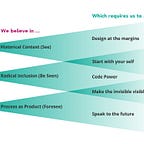Equity is a Verb
The following is the text of remarks given by equityXdesign co-author Christine Ortiz to open New Profit’s 2017 Reimagine Learning Convening. To watch Christine deliver this talk, scroll to the end of the post.
I have never felt more Puerto Rican than I do now.
Which is interesting because I have been very Puerto Rican all of my life. Besides how I look, there were all the typical trappings of a mainland Puerto Rican upbringing. I learned English from sesame street. Ate pernil at thanksgiving and missed the first two weeks of every spring semester because we were in Puerto Rico for Three King’s Day.
But this is different.
You see — At home, my Puerto Rican-ness was just a way of life. But everywhere else, it was a tool. I learned to pull it out in two situations:
1: in small talk — when it could be used to make people feel appropriately multicultural as they shared with me their passion for salsa dancing or love of plantains
Or
2: as the setting for a story in which I erased the core of my lived experience so the darkest pieces of my life could be held in contrast to my triumphs, creating an Algeresque tale that unfailingly opened doors for me and made everyone else feel better about their role as gatekeepers.
I repeated and was rewarded for this story so often I began to believe it myself.
You see — if we define education equity merely as ensuring that demographics don’t predict outcomes you could squarely put me as a tick in the win column. And while I would use many words to describe my educational experience — equitable would not be one.
Equity is not a goal, a set of metrics or a checklist. It is a way of being, a mindset, a practice. Equity is a Verb.
And over the last 29 days, as I have felt the ground fall out from under me time and again, I have been reminded of this — because just as equity is a verb — so is inequity.
And inequity never stops moving.
A routine has emerged for me since the morning of September 20th, 2017. I wake up. I call my mom. I ask for an update. Has she heard from anyone recently? Almost the entirety of my family still lives on the island of Puerto Rico. Most of them in Cabo Rojo, a tiny town on the south west tip of the island. As far as you could get from where Maria’s eye made landfall, they were spared the kind of devastation some of my other family has faced. Having lived for generations in a literal “mountain-side” community outside of Ponce, a number of my great aunt and uncles homes have completely disappeared, simply slid down the side of the mountain.
For most of the first week, with no contact or news, I was paralyzed by the fear and the worry. On day 6, we finally got word that our immediate relatives were all okay. The fear and worry turned into a feeling of impotence. As someone with a huge internal locus of control, this was literally unbearable. To the point where as an escape valve I got the island of Puerto Rico tattooed on my arm. It was cathartic.
And it’s not the tattoo that makes me feel more Puerto Rican now than ever before, but the fact that this storm has finished destroyed the walls I had built — separating my culture at home with my parents from who I was with my friends and colleagues. I am now Puerto Rican — both at home and at work — in private and in public. The storm was a moment of reconciliation — allowing me to realize that my lived reality, my experience was a powerful lens I can use to interrogate and understand the world in which we live, and the world I want to leave for my daughter.
I was paralyzed for a long time, and didn’t know what to do until I read a piece by Yarimar Bonilla who wrote “vulnerability is not simply a product of natural conditions; it is a political state and a colonial condition.” It was that line that reminded me of my own power and the framework EDC had created, which allowed me to see the path forward.
The premise of our work is this: Racism and inequity (and therefore suffering) are products of design. They can be redesigned.
We must recognize the creative agency we hold and the creative agency in each and every person around us. We must believe that we are all designers, and take up the task of redesigning the interactions, interventions and institutions we are all a part of to not just strive towards some “equitable” end goal, but to be equity in motion.
The equityXdesign process is a labor of love created by Caroline Hill from 228 Accelerator, Michelle Molitor from The Equity Lab, & Christine Ortiz from Equity Meets Design. If you like this piece, please hit the heart below so others can see it as well.
If you found this intriguing, stay in touch by joining our mailing lists.
If you are interested in designing for, accelerating and scaling equity in your schools and organizations, please connect with Caroline at caroline@228accelerator.com.
If you’re doing work at the intersection of equity and design, need additional capacity around equity and design in your program or organization, or want to apply equityXdesign to a project, sayhello@equitymeetsdesign.com.
If you’re interested in working to take on our most intractable race, equity, diversity, and inclusion (REDI) problems for your organization or sector, accelerating our transition toward a more liberatory, community-centered society that values the gifts and potential of all its members, contact The Equity Lab at https://www.theequitylab.org/contact/.
